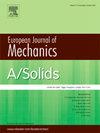Experimental study on macro-slipping in composite single-lap bolted joints with metal inserts
IF 4.4
2区 工程技术
Q1 MECHANICS
引用次数: 0
Abstract
In a preloaded single-lap bolted joint, load transfer between the assembled parts takes place through friction between the parts and then, after slipping, by bolt bearing stress/shear. The maximum load before slipping can therefore be increased by improving the load transfer by adherence at the contact interface of the assembled parts. This can be achieved by optimizing the level of preload in the assembly and maximizing the friction between the assembled parts. In the case of composite parts, with low mechanical properties in the out-of-plane direction, high performance assemblies can be achieved by adding inserts into the holes. This paper proposes a macroscopic analysis of the assembly on load transfer by adherence and friction. An experimental approach is carried out to quantify the influence of the surface condition at the interface of assembled parts (metal inserts) on the load transfer. Several techniques are used to modify the characteristics of the contact interface: laser texturing with a concentric circular pattern or a cross hatch pattern, and the addition of a friction shim at the interface. The analysis is carried out on the macroscopic scale of the assembly, based on post-mortem observations of the surfaces in contact, to validate the global behaviour of the assembly. Compared to results for a machined surface, these results show an increase in the friction coefficient and therefore in the pre-slipping load for all the configurations proposed. However, the interposition of a friction shim provides interesting results, with an increase in the friction coefficient (+205 % for the static friction coefficient) compared to the reference surface condition. The effect of a disassembly-reassembly operation is also studied and the benefits of adding a friction shim to the load transfer are validated by a tensile test on a single-lap composite bolted joint.
金属镶件复合材料单搭螺栓连接宏观滑移试验研究
在预加载单搭螺栓连接中,通过部件之间的摩擦,然后在滑动后通过螺栓承载应力/剪切,在组装部件之间进行载荷传递。因此,滑移前的最大载荷可以通过在装配部件的接触界面上粘附来改善载荷传递来增加。这可以通过优化装配中的预载荷水平和最大化装配部件之间的摩擦来实现。对于复合材料零件,在面外方向机械性能较低的情况下,可以通过在孔中添加插入件来实现高性能组件。本文从宏观上分析了粘着和摩擦对装配载荷传递的影响。采用实验方法量化了装配件(金属镶件)界面表面状况对载荷传递的影响。采用了几种技术来改变接触界面的特性:用同心圆形图案或交叉舱口图案进行激光纹理,并在界面处添加摩擦垫片。分析是在装配的宏观尺度上进行的,基于对接触表面的事后观察,以验证装配的全局行为。与加工表面的结果相比,这些结果表明摩擦系数有所增加,因此在所提出的所有配置中,预滑动载荷都有所增加。然而,摩擦片的插入提供了有趣的结果,与参考表面条件相比,摩擦系数增加(静摩擦系数+ 205%)。还研究了拆装操作的影响,并通过单搭复合螺栓连接的拉伸试验验证了在载荷传递中添加摩擦垫片的好处。
本文章由计算机程序翻译,如有差异,请以英文原文为准。
求助全文
约1分钟内获得全文
求助全文
来源期刊
CiteScore
7.00
自引率
7.30%
发文量
275
审稿时长
48 days
期刊介绍:
The European Journal of Mechanics endash; A/Solids continues to publish articles in English in all areas of Solid Mechanics from the physical and mathematical basis to materials engineering, technological applications and methods of modern computational mechanics, both pure and applied research.

 求助内容:
求助内容: 应助结果提醒方式:
应助结果提醒方式:


